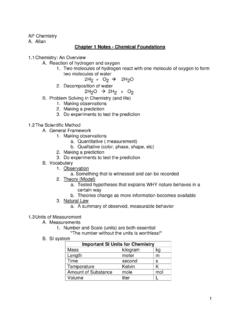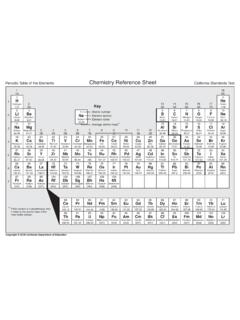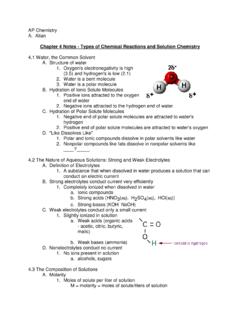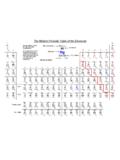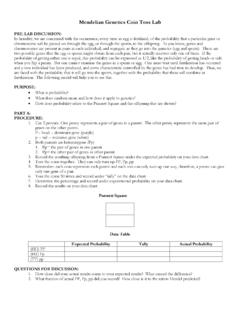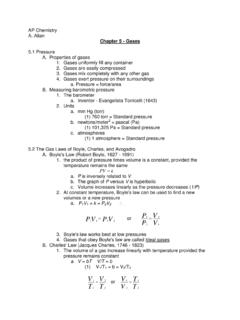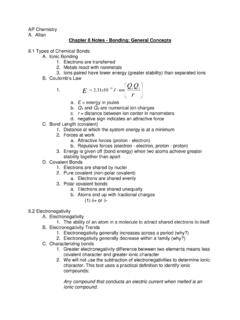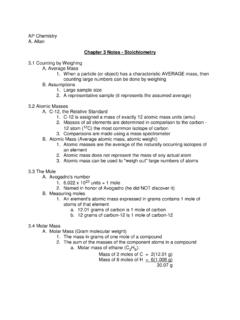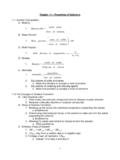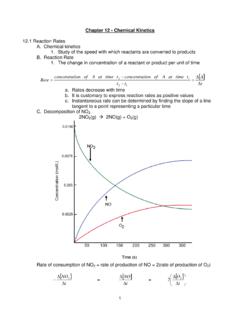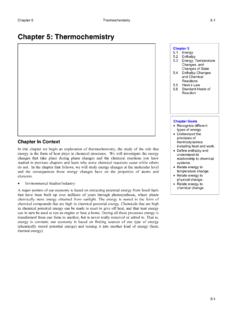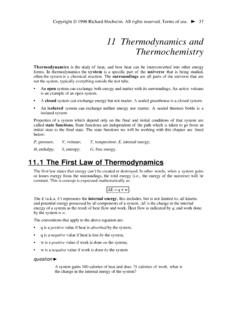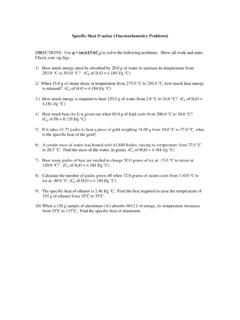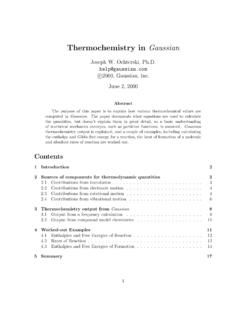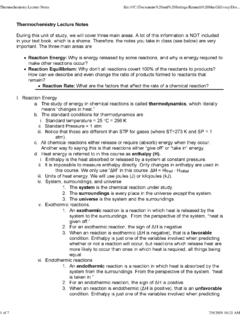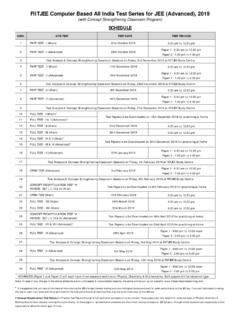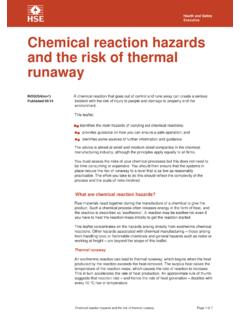Transcription of KE m v - ScienceGeek.net
1 AP Chemistry A. Allan Chapter Six Notes - thermochemistry The Nature of Energy A. Definition 1. Energy is the capacity to do work (or to produce heat*) a. Work is a force acting over a distance (moving an object) b. *Heat is actually a form of energy. (1) chemicals may store potential energy in their bonds that can be released as heat energy B. Law of Conservation of Energy 1. Energy can be converted from one form to another, but cannot be created or destroyed a. Potential energy (1) energy due to position or composition b.
2 Kinetic energy (1) energy due to the motion of an object (2) vmKE221= C. Heat and Temperature 1. Temperature reflects random motion of particles in a substance 2. Temperature indicates the direction in which heat energy will flow 3. Heat is a measure of energy content 4. Heat is what is transferred during a temperature change D. State Functions 1. A property of a system that depends only on its present state. 2. State functions do not depend on what has happened in the system, or what might happen in the system in the future 3.
3 State functions are independent of the pathway taken to get to that state. Example: a liter of water behind a dam has the same potential energy for work regardless of whether it flowed downhill to the dam, or was taken uphill to the dam in a bucket. The potential energy is a state function dependent only on the current position of the water, not on how the water got there. E. Chemical Energy 1. Exothermic reactions a. Reactions that give off energy as they progress b. Some of the potential energy stored in the chemical bonds is converted to thermal energy (random KE) through heat c.
4 Products are generally more stable (stronger bonds) than reactants 2. Endothermic reactions a. Reactions in which energy is absorbed from the surroundings b. Energy flows into the system to increase the potential energy of the system c. Products are generally less stable (weaker bonds) than the reactants F. Thermodynamics 1. System Energy wqE+= a. q = heat (1) q is positive in endothermic reactions (2) q is negative in exothermic reactions b. w = work (1) w is negative if the system does work (2) w is positive if work is done on the system 2.
5 Work done by gases VPw = a. by a gas (through expansion) (1) V is positive (2) w is negative b. to a gas (by compression) (1) V is negative (2) w is positive Enthalpy and Calorimetry A. Enthalpy PVEH+= 1. In systems at constant pressure, where the only work is PV, the change in enthalpy is due only to energy flow as heat ( H = heat of rxn) HHHtsreacproductstan = a. H is negative for exothermic rxns b. H is positive for endothermic rxns B. Calorimetry - science of measuring heat 1. Heat capacity (C) a.
6 Ratio of heat absorbed to increase in temperature increaseeTemperaturabsorbedheatC= 2. Specific Heat Capacity a. Energy required to raise the temp of 1 gram of a substance by 1 C 3. Molar heat capacity a. Energy required to raise the temp of 1 mole of a substance by 1 C C. Constant Pressure Calorimetry (solutions) 1. Calculating Heat of Rxn, H a. H = specific heat capacity x mass of sol'n x increase in temp TmsHxx = 2. Heat of rxn is an extensive property - dependent on the amount of substance a.
7 H moles of reactant D. Constant Volume Calorimetry 1. Volume of bomb calorimeter cannot change, so no work is done 2. The heat capacity of the calorimeter must be known, generally in kJ/ C 2. wqE+= , 0=w qE= Hess's Law A. Statement of Hess's Law 1. In going from a particular set of reactants to a particular set of products, the change in enthalpy ( H) is the same whether the reaction takes place in one step or in a series of steps One step: N2 (g) + 2O2 (g) 2NO2 (g) H1 = 68kJ Two step N2 (g) + O2 (g) 2NO (g) H2 = 180kJ 2NO (g) + O2 (g) 2NO2 (g) H3 = -112kJ N2 (g) + 2O2 (g) 2NO2 (g) H2 + H3 = 68kJ B.
8 Characteristics of Enthalpy Changes 1. If a reaction is reversed the sign on H is reversed N2 (g) + 2O2 (g) 2NO2 (g) H = 68kJ 2NO2 (g) N2 (g) + 2O2 (g) H = - 68kJ 2. The magnitude of H is directly proportional to the quantities of reactants and products in a reaction. If the coefficients in a balanced reaction are multiplied by an integer, the value of H is multiplied by the same integer C. Using Hess's Law 1. Work backward from the final reaction 2. Reverse reactions as needed, being sure to also reverse H 3.
9 Remember that identical substances found on both sides of the summed equation cancel each other Standard Enthalpies of Formation A. Standard State 1. For a compound a. Gaseous state (1) pressure of 1 atm b. Pure liquid or solid (1) standard state is the pure liquid or solid c. Substance in solution (1) concentration of 1 M 2. For an element a. the form in which the element exists at 1 atm and 25 C B. Standard Enthalpy of Formation ( Hf ) 1. The change in enthalpy that accompanies the formation of one mole of a compound from its elements with all elements in their standard state C.
10 Calculating enthalpy change 1. When a rxn is reversed, the magnitude of H remains the same, but its sign changes 2. When the balanced eqn for a rxn is multiplied by an integer, the value of H must be multiplied by the same integer 3. The change in enthalpy for a rxn can be calculated from the enthalpies of formation of the reactants and products ()()tsreacproductsHnHnHfrfpreactiontan = 4. Elements in their standard states are not included a. For elements in their standard state, Hf = 0 Present Sources of Energy A.
